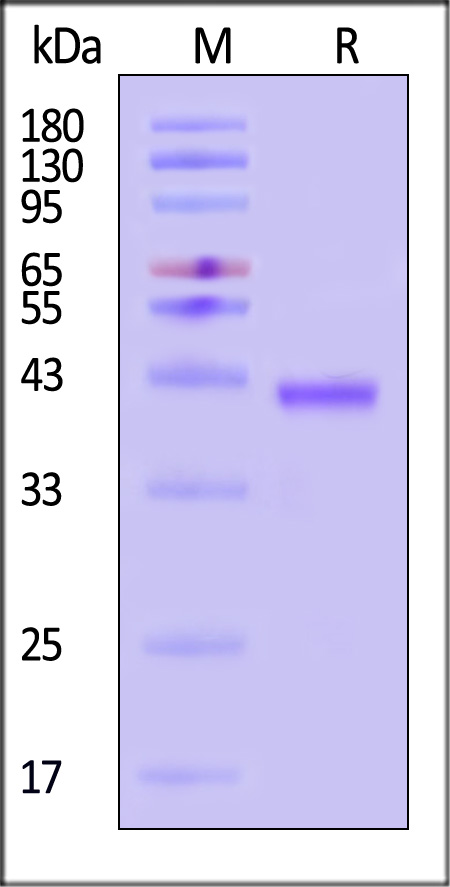分子别名(Synonym)
RECQ3, RECQL2, RECQL3
表达区间及表达系统(Source)
Human WRN Protein, His Tag (WRN-H5143) is expressed from E. coli cells. It contains AA Ser 2 - Ile 333 (Accession # Q14191-1).
Predicted N-terminus: Met
Request for sequence
蛋白结构(Molecular Characterization)

This protein carries a polyhistidine tag at the N-terminus.
The protein has a calculated MW of 39.9 kDa. The protein migrates as 40-43 kDa when calibrated against Star Ribbon Pre-stained Protein Marker under reducing (R) condition (SDS-PAGE).
内毒素(Endotoxin)
Less than 1.0 EU per μg by the LAL method.
纯度(Purity)
>90% as determined by SDS-PAGE.
制剂(Formulation)
Supplied as 0.2 μm filtered solution in 50 mM Tris, 150 mM NaCl, pH7.5 with glycerol as protectant.
Contact us for customized product form or formulation.
运输(Shipping)
This product is supplied and shipped with dry ice, please inquire the shipping cost.
存储(Storage)
Please avoid repeated freeze-thaw cycles.
This product is stable after storage at:
- The product MUST be stored at -70°C or lower upon receipt;
- -70°C for 3 months under sterile conditions.
电泳(SDS-PAGE)

Human WRN Protein, His Tag on SDS-PAGE under reducing (R) condition. The gel was stained with Coomassie Blue. The purity of the protein is greater than 90% (With Star Ribbon Pre-stained Protein Marker).
背景(Background)
This gene encodes a member of the RecQ subfamily of DNA helicase proteins. The encoded nuclear protein is important in the maintenance of genome stability and plays a role in DNA repair, replication, transcription and telomere maintenance. This protein contains a N-terminal 3' to 5' exonuclease domain, an ATP-dependent helicase domain and RQC (RecQ helicase conserved region) domain in its central region, and a C-terminal HRDC (helicase RNase D C-terminal) domain and nuclear localization signal. Defects in this gene are the cause of Werner syndrome, an autosomal recessive disorder characterized by accelerated aging and an elevated risk for certain cancers. [provided by RefSeq, Aug 2017]























































 膜杰作
膜杰作 Star Staining
Star Staining











